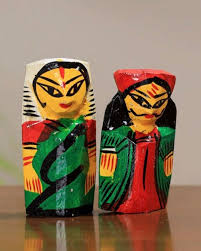
The visual culture of Bardhaman’s royal courts was defined not only by architecture and painting but also by the grandeur of costume and pageantry. In traditional Bardhaman art—especially portraiture, sculpture, and festival tableaux—the attire of royals and nobles became an expressive language of power, elegance, and regional identity. Every turban fold, silk drape, and jewelry ornament told a story of lineage, authority, and aesthetic taste.
Maharajas and Maharanis of Bardhaman were known for their richly layered costumes that combined Mughal, Bengali, and later colonial influences. Men wore finely woven jamdani or silk angarakhas, adorned with brocade borders, paired with elaborate turbans and ceremonial sashes. Women favored luxurious saris with gold zari work, often paired with temple-style jewelry sets that included heavy earrings, layered necklaces, and ornate waistbands. These garments and accessories became visual symbols of status, often featured prominently in paintings and public ceremonies.
Pageantry, especially during durbars and religious festivals, amplified this cultural spectacle. During events like the Rath Yatra or royal birthdays, the royal family would appear in full regalia, accompanied by musicians, dancers, and decorated elephants or horses. These moments were often captured by court artists, who recreated the splendor in detailed visual compositions, blending realism with idealism.
Costume also played a crucial role in reinforcing the social hierarchy of the court. Artists carefully depicted the differences between rulers, courtiers, attendants, and performers through dress, posture, and accessories. Even colonial guests or British officials portrayed in Bardhaman paintings were shown in distinctive attire, highlighting their external but influential presence.
Today, surviving portraits, festival photographs, and a few restored costumes remain vital sources for understanding this rich textile and design heritage. Bardhaman’s courtly fashion was not just about clothing—it was a curated statement of cultural refinement and political legacy, woven into every thread.